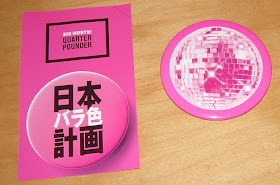
Tirol releases a constant stream of "variety packs" for about a dollar (100 yen) a pack. When I first started doing these reviews, I was interested in trying all the various packs, but my enthusiasm has since waned. One of the reasons for this is that often these packs include a couple of old flavors and perhaps one or two limited edition or new flavors. You can pretty much bet on the mix being calculated so that the newer flavor is there to lure people to buy 9 candies to sample one or two.
The package contains 9 candies and the distribution is annoying. They give you 3 of the rather pedestrian "Bis" (biscuit) candies instead of tripling up on the mini version of one of the "premium" flavor candies. I counted how many were in more than one pack when I bought this at the store, so I'm sure it wasn't just the packet I bought.

The candies are molded with a top pattern like most mini versions of Tirol chocolates except for the almond one which has an almond embossed on top of it (click this picture to load a larger version to see more detail).
Cappucino Choco:
This smells a lot like instant coffee. There are two distinct layers and each is a different flavor. The taste is mixed between slightly bitter instant coffee (like Nescafé) and sweet milky white chocolate. Most Tirol candies I've had are very soft, but this is dense and chalky with a strong snap. If you like instant coffee and white chocolate, you'll love this. If you're looking more for an espresso taste, which I'd prefer, this is okay, but not great. I think the coffee portion would have benefited from a little cinnamon to add depth to the flavor.
Almond:
This smells like milk chocolate or cocoa powder. It tastes like pretty decent milk chocolate with a super crispy deeply roasted and crunchy almond. There's a nice mix of almond and chocolate flavor but a bit of a bitter aftertaste from the chocolate.

Milk Mochi:
This flavor is the one which compelled me to purchase the mix. It smells like white chocolate and, unfortunately, tastes mostly like overly sweet white chocolate with a chewy gummy center. There seems to be a tiny lemon note. To get a sense of the mochi center, I sucked off the coating from the second half of the piece I sampled so I could eat only the gummy. It had very little flavor, but nice texture. This was a big disappointment.
Bis:
I already knew that the Bis was going to be a little bland, crunchy cookie in milk chocolate and it smelled like cheap chocolate. The chocolate tastes flat, like there isn't enough milk in it and there's too much sugar. It's also firmer that usual for a Tirol chocolate. There's a lot of crunch from the cookie which dominates most of it, There's also a rather intense cocoa flavor from the thin chocolate coating. It seems that the chocolate was made extra potent so that less of it could be used to surround the cookie while still holding the chocolate flavor.
The almond was the winner from this pack. The rest was fairly disappointing, but by no means bad. I'll finish the bag eventually, but I have no desire to buy any of the varieties included in this bag again except the almond. The milk mochi variety is classified as "rare" on the Tirol web site and comes in two different color packages (blue and pink). It also says that you can only get these in variety packs, which I believe means there is no premium version sold individually. It's not worth buying a variety pack for, nor worth seeking out as a rarity.














































